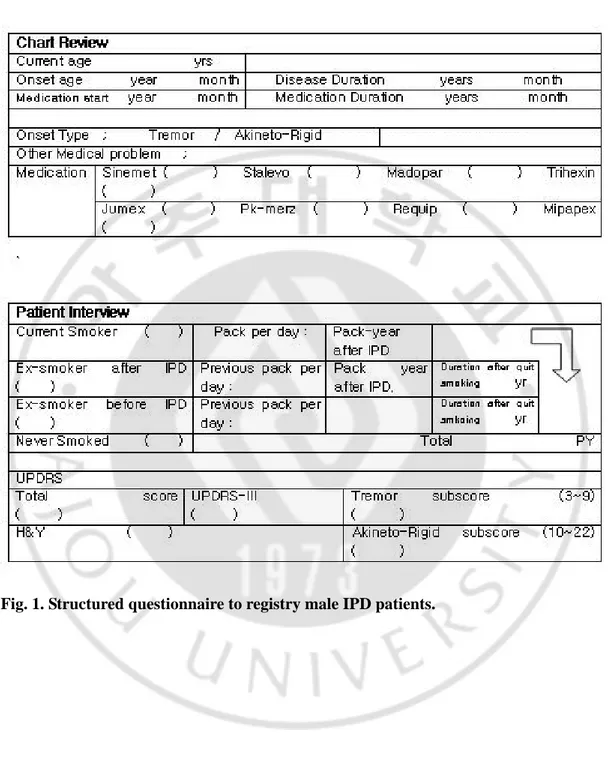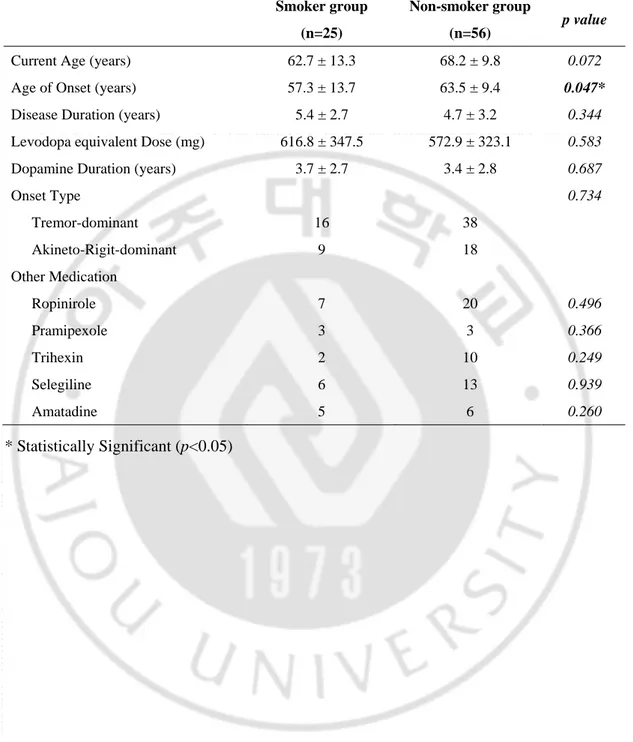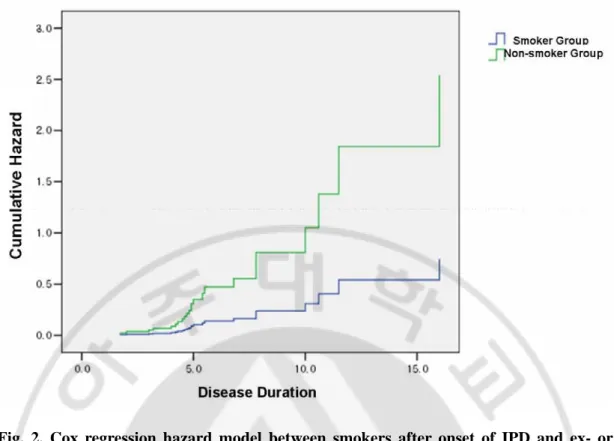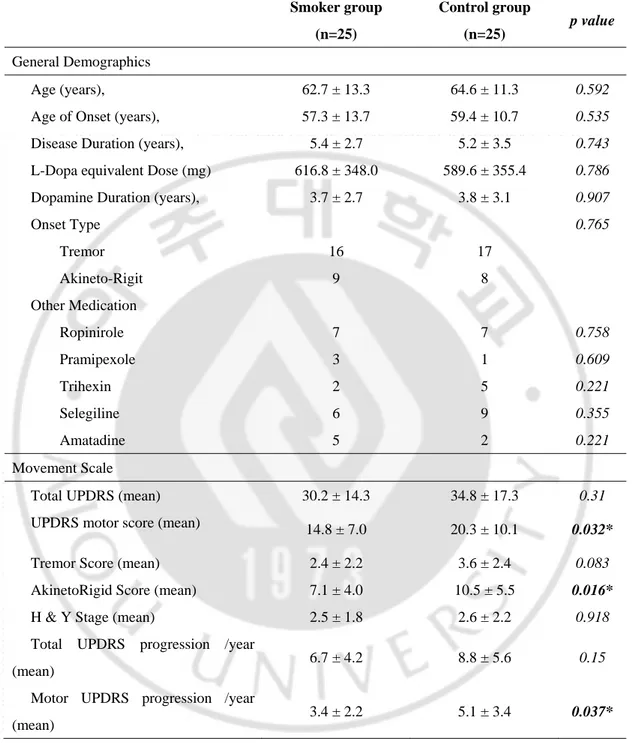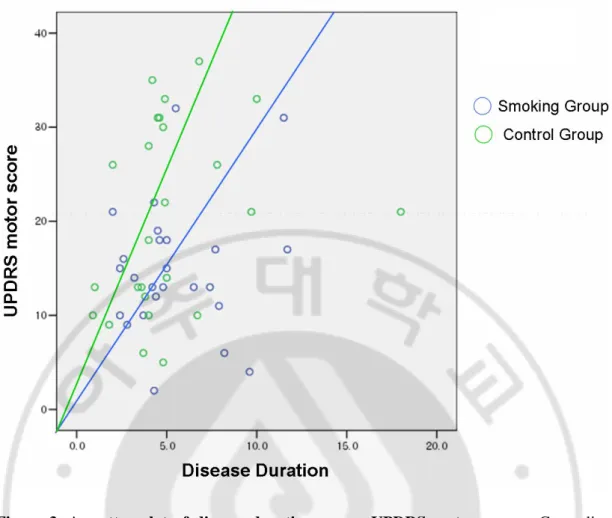저작자표시-비영리-변경금지 2.0 대한민국 이용자는 아래의 조건을 따르는 경우에 한하여 자유롭게 l 이 저작물을 복제, 배포, 전송, 전시, 공연 및 방송할 수 있습니다. 다음과 같은 조건을 따라야 합니다: l 귀하는, 이 저작물의 재이용이나 배포의 경우, 이 저작물에 적용된 이용허락조건 을 명확하게 나타내어야 합니다. l 저작권자로부터 별도의 허가를 받으면 이러한 조건들은 적용되지 않습니다. 저작권법에 따른 이용자의 권리는 위의 내용에 의하여 영향을 받지 않습니다. 이것은 이용허락규약(Legal Code)을 이해하기 쉽게 요약한 것입니다. Disclaimer 저작자표시. 귀하는 원저작자를 표시하여야 합니다. 비영리. 귀하는 이 저작물을 영리 목적으로 이용할 수 없습니다. 변경금지. 귀하는 이 저작물을 개작, 변형 또는 가공할 수 없습니다.
Effect of Cigarette Smoking on
Disease Progression in Idiopathic
Parkinson's Disease Patients
by
Jun Young Choi, M.D.
Major in Medicine
Department of Medical Sciences
The Graduate School, Ajou University
Effect of Cigarette Smoking on Disease
Progression in Idiopathic Parkinson's Disease
Patients
by
Jun Young Choi, M.D.
A Dissertation Submitted to The Graduate School of Ajou University
in Partial Fulfillment of the Requirements for the Degree of
Master of Medicine
Supervised by
In Soo Joo, M.D.
Major in Medicine
Department of Medical Sciences
The Graduate School, Ajou University
This certifies that the dissertation
of Jun Young Choi is approved.
SUPERVISORY COMMITTEE
In Soo Joo
Ji Man Hong
So Young Moon
The Graduate School, Ajou University
December, 21st, 2009
- Abstract –
Effect of cigarette smoking on disease progression in idiopathic
Parkinson’s disease patients
Introduction: Cigarette smoking is known to have a protective role against the development
of idiopathic Parkinson’s disease (IPD). Despite this, there have been few studies focusing on whether cigarette smoking is able to slow IPD disease progression. The few that have examined this issue must be regarded with care due to their intrinsic methodological problems which have likely hampered their power to detect any potential neuroprotective effect of cigarette smoking. Given that a relatively small proportion of female IPD patients has a history of smoking it is reasonable to distinguish disease progression relative to gender, or simply to include only male patients, neither of which the previous studies did. We therefore evaluated the neuroprotective role of cigarette smoking in male IPD patients.
Method: A total of 81 male IPD patients, who regularly visited Ajou University hospital
neurologic clinic, were enrolled in this study. All patients were evaluated by means of a structured questionnaire. General demographic data and Unified Parkinson’s Disease Rating Scale (UPDRS) results were compared for each group in order to determine the effects of smoking on IPD progression.
Results: Among 81 patients, 25 patients (smoker group) were current smokers or stopped
smoking only after the IPD symptomatic onset. The remaining 56 patients (non-smoker group) were those who had ceased smoking prior to the onset of IPD symptoms or those who
had never smoked. The age (62.7 yrs Vs. 68.2 yrs, p=0.072), disease duration (5.3 yrs Vs. 4.8 yrs, p=0.344), and levodopa dosage (616.8 mg Vs. 572.9 mg, p=0.583) were similar between the smoker group and non-smoker group. However, the age of IPD onset (57.3 yrs Vs. 63.5 yrs, p=0.047), UPDRS motor scores (14.8 Vs. 19.1, p=0.034), particularly the akineto-rigid subscores (7.1 point Vs. 9.7 point, p=0.022), and the UPDRS motor score progression rates were lower in the smoker group than those in the non-smoker group (3.4 points /year Vs. 5.3 points /year, p=0.007). In a Cox regression analysis, the age of IPD onset was the most significant prognostic factor. When 25 patients from the smoker group were matched to the age of IPD onset and onset phenotype matched controls for 25 patients from the non-smoker group, the smoker group still had a lower UPDRS motor score (14.8 points Vs. 20.3 points,
p=0.032), and a lower UPDRS motor score progression rate than the non-smoker group (3.4
points per year Vs. 5.1 points per year, p=0.037).
Conclusion: This study demonstrated that the continuation of cigarette smoking has a
protective effect in male IPD, effectively slowing the rate of disease progression. Even after adjusting for the age of IPD onset, smoking was still identified as being able to significantly slow the progression of IPD.
TABLE OF CONTENTS
ABSTRACT ··· ⅰ TABLE OF CONTENTS ··· iii LIST OF FIGURES ··· iv LIST OF TABLES ··· v . INTRODUCTION Ⅰ ··· 1 . METHOD Ⅱ ··· 4 A. SUBJECTS AND EVALUATION ··· 4 B. STATISTICAL ANALYSIS ··· 7 . RESULTS
Ⅲ ··· 8 A. GENERAL DEMOGRAPHICS ··· 8 B. MOVEMENT SCALES ··· 10 C. COMPARISON AFTER CONTROLLING FOR AGE OF ONSET AND ONSET PHENOTYPE ··· 13 . DISCUSSION
Ⅳ ··· 16 REFERENCES ··· 20 국문요약 ··· 27
LIST OF FIGURES
Fig. 1. Structured questionnaire form to registry male IPD patients ··· 6
Fig. 2. Graph of Cox hazard regression analysis ··· 12
Fig. 3. Graph of United Parkinson’s Disease Rating Scale (UPDRS) motor score progression rate between smoker and non-smoker group ··· 15
LISTS OF TABLES
Table 1. General demographics of the subjects ··· 9
Table 2. Movement scales between smoker group and non-smoker group ··· 11
I.
INTRODUCTION
Idiopathic Parkinson’s disease (IPD) is a progressive neurodegenerative disorder characterized by tremor, rigidity, bradykinesia, and postural instability. Together with Alzheimer’s disease (AD), IPD is one of the most common neurodegenerative diseases, with a lifetime risk of developing IPD at 1.5% (Allam et al., 2005; Brown et al., 2005; de Lau et al., 2004; de Rijk et al., 1995; de Rijk et al., 2000; Gorell et al., 2004). The motor symptoms characteristic of IPD are caused by dopaminergic neuronal loss in the substantia nigra within the midbrain. Although the exact cause of dopaminergic neuronal loss has not been clearly elucidated, genetic factors, infections, oxygen free radicals, or environmental factors have been proposed as possible etiologies (Dick et al., 2007a; Dick et al., 2007b; Doty, 2008). Pathologically, IPD is characterized by the presence of Lewy bodies (Samii et al., 2004), which appear prior to the typical IPD motor phenomena emerge, and which accumulate in the central nervous system, particularly in the olfactory bulb and lower brainstem (Braak et al., 2003; Hawkes, 2008). Overtime, Lewy bodies accumulate beyond the brainstem and eventually reach the cerebral cortex while at the same time, dopaminergic neurons in the substantia nigra gradually disappear (Braak et al., 2003). As neuronal loss and Lewy body accumulation progress, IPD motor phenomena worsen (Alves et al., 2005). Given the understanding of IPD progression, there have been many studies that have attempted to establish factors that influence the speed of IPD progression. It has been demonstrated that gender, age of IPD onset, onset phenotype, and lower Unified Parkinson’s Disease Rating Scores (UPDRS) at IPD onset seem to be influential factors in determining IPD progression
(Alves et al., 2005; Post et al., 2007).
Treatment of IPD is usually symptomatic and relies heavily on the replenishment of dopamine (2004; Fahn et al., 2004; Lees et al., 2009; Samii et al., 2004). However, this form of treatment has its limitations, as over time, adverse effects such as the wearing off of drug efficacy and levodopa-induced dyskinesias occur.
Interesting results can be deduced from epidemiologic studies of IPD. For example, cigarette smoking has repeatedly been shown to have a protective role against the development of IPD (Ritz et al., 2007). In fact, several case-control studies and prospective cohort investigations have supported this observation (Grandinetti et al., 1994; Hellenbrand et al., 1997). It is assumed that the pharmacological activity of several compounds in cigarette smoke has a protective effect against development of IPD.
Given that cigarette smoke has been demonstrated to be protective effect against IPD, one may then hypothesize that cigarette smoke may also slow the rate of disease progression in patients who have already established IPD. Unfortunately, this optimistic hypothesis has not supported by literature related to this matter (Alves et al., 2004; Kandinov et al., 2007; Papapetropoulos et al., 2005). In fact, these studies have claimed that while smoking may protect from the development of IPD, it cannot slow down its progression once it has developed inside the nervous system.
It is possible that these contradictory studies found negative results because of the existence of their intrinsic methodological shortcomings. For example, these studies included both male and female patients together without considering the fact that male patients represent a significantly higher proportion of smokers. As a result, their study populations
were comprised of significant portions of male smokers and female non-smokers, inherently making them prone to biased observations. In addition, these studies also failed to take into account other factors that influence the rate of disease progression such as age of onset and phenotype of motor symptom (i.e. tremor dominant Vs. akineto-rigid dominant phenotypes).
Based on this discrepancy, in this study we studied the rate of disease progression in male IPD patients while taking into account other factors that have been shown to contribute to IPD progression.
II. METHOD
A. Subject and Evaluation
We enrolled male IPD patients who had visited our Ajou University Hospital neurology clinic for regular follow-ups from Oct. 2008 to Feb. 2009. The diagnosis of IPD was based on the United Kingdom Parkinson’s Disease Society Brain Bank (UK PDS Brain Bank) clinical diagnostic criteria (Hughes et al., 1992). The UKPDS diagnostic criteria are composed of three steps, the first of which is characterized by core features of IPD such as bradykinesia, resting tremor, rigidity, and postural instability. The second step is characterized by sixteen exclusion criteria and the third step, by eight supportive criteria.
Out of 83 candidate male patients, two patients were excluded. One patient had undergone previous deep brain stimulation surgery of the subthalamic nucleus, while the other patient had received a secondary diagnosis of severe cerebral amyloid angiopathy (CAA) based on a brain magnetic resonance image (MRI). Exclusion was agreed upon as these conditions were expected to have significantly altered the natural disease course of IPD.
All patients were interviewed by experienced neurologists in order to evaluate their disease history and current Unified Parkinson’s Disease Rating Scale (UPDRS) status. The UPDRS is composed of four parts, the first part being of which is mentation, behavior, and mood. The second part measures the patient’s activities of daily living, while the third part also known as the UPDRS motor score, measures the motor symptoms of PD, and is thought of as the critical marker in evaluating disease progression. The overall UPDRS motor score
is comprised of several subscores composed of tremor, akineto-rigid, speech, facial expression, posture, and gait subscores. The fourth part measures the complications of drug therapy. Total UPDRS scores are the sum of all four parts of UPDRS.
In this study, motor symptoms were examined while patients were on medication. In addition, smoking histories were taken from patients and their family members using structured questionnaires (Figure 1.). Results from which were grouped into: 1) smoker group for those who were current smokers or those who had quit smoking only after the IPD symptomatic onset or 2) non-smoker group which was composed of two subgroups groups. The first of these were those who quit smoking before IPD symptomatic onset, and the second were those who never smoked. Age of IPD onset was defined as the point in time which the patients or their family members identified for the emergence of parkinsonian motor symptoms such as tremor, rigidity, bradykinesia, or gait difficulty.
Patient age, age of IPD onset, disease duration, medication dosage (calculated as Levodopa equivalent dosage), Total UPDRS scores, UPDRS motor scores, Hoehn and Yahr stages, and onset phenotypes (ie. Tremor dominant versus akineto-rigid dominant type) were taken into account in the analysis. Levodopa equivalent dosages were standardized with the use of a formula following from this equation: 100mg standard levodopa = 125mg sustained-release levodopa, 1.5mg pramipexole, 6mg ropinirole, 10mg bromocriptine or 1mg pergolide (Pahwa et al., 1997; Thobois et al., 2002).
B. Statistical analysis
A chi-square test was used for determining differences in proportions for categorical variables and the Student’s t-test, to compare means for continuous variables. A Pearson’s correlation was used for examining the correlation between pack-years after IPD onset and the rate of disease progression in all enrolled patients. The rate of disease progression was deduced using the UPDRS (total scores or motor scores) divided by disease duration in years. A Cox regression model including age of IPD onset, onset subtype, and smoking subgroup was used to calculate the relative risk for disease progression between smokers and ex- or non-smokers. Event in the Cox regression model was defined as UPDRS motor scores being greater than the score of the highest quartile for all enrolled patients’ UPDRS part III scores. A p-value of less than 0.05 was considered to indicate a statistically significant difference. All statistical analyses were performed using SPSS 13.0 (SPSS, Inc., Chicago, IL).
III. RESULTS
A. General Demographics
(Table 1) summarizes general demographics between the two groups. Among 81 enrolled patients, 25 patients were the smoker group and 56 patients were the non-smoker group. Compared with the non-smoker group, the smoker group showed younger age of disease onset (57.3 yrs Vs. 63.5 yrs, p=0.047) and smoker group also showed also younger age trend of disease onset although there was no statistical significance (62.7 yrs Vs. 68.2 yrs,
p=0.072). While there was slightly longer disease duration and medication duration in
smoker group, there was no statistical significance between two groups (5.3 yrs Vs. 4.8 yrs,
p=0.344, 3.7 yrs Vs. 3.4 yrs, p=0.687). All of enrolled patients were treated with levodopa.
Levedopa equivalent dosage was also similar between two groups (616.8 mg Vs. 572.9 mg, p=0.583). Use of medication other than levodopa had no difference between two groups. Onset phenotype showed no difference between groups also.
Table 1. General demographics between two groups.
Smoker group (n=25)
Non-smoker group
(n=56) p value
Current Age (years) 62.7 ± 13.3 68.2 ± 9.8 0.072 Age of Onset (years) 57.3 ± 13.7 63.5 ± 9.4 0.047*
Disease Duration (years) 5.4 ± 2.7 4.7 ± 3.2 0.344 Levodopa equivalent Dose (mg) 616.8 ± 347.5 572.9 ± 323.1 0.583 Dopamine Duration (years) 3.7 ± 2.7 3.4 ± 2.8 0.687
Onset Type 0.734 Tremor-dominant 16 38 Akineto-Rigit-dominant 9 18 Other Medication Ropinirole Pramipexole 7 3 20 3 0.496 0.366 Trihexin 2 10 0.249 Selegiline 6 13 0.939 Amatadine 5 6 0.260 * Statistically Significant (p<0.05)
B. Movement Scales
(Table 2) summarizes a comparison of movement scales between the two groups. The smoker group had significantly lower UPDRS motor scores (14.8 Vs. 19.1, p=0.034); however, the total UPDRS score didn’t indicated any statistical differences between the two groups (30.2 point Vs. 32.3 point, p=0.587). With respect to the UPDRS motor scores, while tremor subscores between the two groups didn’t show a difference (2.4 point Vs. 3.6 point,
p=0.09), akineto-rigid subscores did (7.1 point Vs. 9.7 point, p=0.022). Additionally, the total
UPDRS progression rate exhibited a lower trend in the smoker group although it did not achieve statistical significance (6.7 points /year Vs. 8.9 points /year, p=0.135). On the contrary, the UPDRS motor progression rate demonstrated a lower progression rate in the smoker group (3.4 points /year Vs. 5.3 points /year, p=0.007). The Hoehn-Yahr stage didn’t show a difference between the two groups (2.5 Vs. 2.3, p=0.655). In addition, there was no correlation between post-IPD smoking pack-year and UPDRS motor score or UPDRS progression rate (r2=0.042, p=0.065 in UPDRS progression rate, r2=0.010, p=0.382 in UPDRS motor scores). In the Cox hazard regression model, which included an adjustment for age of onset, onset subtype, and smoking subtype, patients with an older age of onset had a higher probability of reaching the highest quartile with respect to UPDRS motor scores (more than 22 points) during disease progression (RR: 1.079, 95% CI: 1.020 to 1.141,
p=0.008). Also, the smoker group had a tendency to have a lower probability of progressing
to a high UPDRS motor score although there was no statistical significance (RR : 0.294, 95% CI: 0.085 to 1.016, p=0.053). Figure 2 illustrates the Cox hazard regression curve
labeled with the smoker and non-smoker groups
Table 2. Comparison of movement scales between smoker group and non-smoker group.
Smoker group (n=25)
Non-smoker
(n=56) p value
Total UPDRS (mean) 30.2 ± 14.3 32.3 ± 17.1 0.587 UPDRS motor score (mean) 14.8 ± 7.0 19.1 ± 10.4 0.034*
Tremor Score (mean) 2.4 ± 2.2 3.6 ± 3.3 0.09 AkinetoRigid Score (mean) 7.1 ± 4.0 9.7 ± 5.7 0.022*
H & Y Stage (mean) 2.5 ± 1.8 2.3 ± 1.6 0.655 Total UPDRS progression /year (mean) 6.7 ± 4.2 8.9 ± 6.7 0.135 Motor UPDRS progression /year (mean) 3.4 ± 2.2 5.3 ± 3.9 0.007*
* Statistically Significant (p<0.05)
Fig. 2. Cox regression hazard model between smokers after onset of IPD and ex- or never-smokers. This figure shows continuing smokers after onset of IPD had lower
possibility to progress high UPDRS motor score, although there was not statistical significance. (RR : 0.294, 95% CI: 0.085 to 1.016, p=0.053)
C. Comparison after controlling for age of onset and onset phenotype
Predefined outcome analysis revealed that age of IPD onset was the most predictive factor of IPD progression while smoking habits also seemed to slow the disease progression as measured by UPDRS III / disease duration. Because age of onset was the only predictive factor of disease progression in the Cox regression model, we re-evaluated the effect of cigarette smoking in the smoker group after adjusting for the age of IPD onset and onset phenotype, both of which are known to be definite factors in the rate of IPD progression. The control group, which was matched for the two aforementioned variables, consisted of 25 patients selected from the non-smoker group.
(Table 3) summarizes general demographics and movement scales of the smoker and control groups. Current age, IPD duration, medication duration, and use of medication other than levodopa were not significantly different between the two groups. Additionally, UPDRS total scores, tremor subscores, Hoehn-Yahr stages, and UPDRS total score progression rates were not different. However, UPRDRS motor scores (14.8 points Vs. 20.3 points, p=0.032), akineto-rigid subscores (7.1 points Vs. 10.5 points, p=0.016), and UPDRS motor score progression rates (3.4 points per year Vs. 5.1 points per year, p=0.037) were statistically different between the two groups. Figure 3 illustrates UPDRS motor scale progression between smoker group and non-smoker group after controlling age of onset.
Table 3. Comparison of general demographics and movement scale between two groups after age of IPD onset adjustment
Smoker group (n=25) Control group (n=25) p value General Demographics Age (years), 62.7 ± 13.3 64.6 ± 11.3 0.592 Age of Onset (years), 57.3 ± 13.7 59.4 ± 10.7 0.535 Disease Duration (years), 5.4 ± 2.7 5.2 ± 3.5 0.743 L-Dopa equivalent Dose (mg) 616.8 ± 348.0 589.6 ± 355.4 0.786 Dopamine Duration (years), 3.7 ± 2.7 3.8 ± 3.1 0.907
Onset Type 0.765 Tremor 16 17 Akineto-Rigit 9 8 Other Medication Ropinirole Pramipexole 7 3 7 1 0.758 0.609 Trihexin 2 5 0.221 Selegiline 6 9 0.355 Amatadine 5 2 0.221 Movement Scale
Total UPDRS (mean) 30.2 ± 14.3 34.8 ± 17.3 0.31 UPDRS motor score (mean) 14.8 ± 7.0 20.3 ± 10.1 0.032* Tremor Score (mean) 2.4 ± 2.2 3.6 ± 2.4 0.083 AkinetoRigid Score (mean) 7.1 ± 4.0 10.5 ± 5.5 0.016*
H & Y Stage (mean) 2.5 ± 1.8 2.6 ± 2.2 0.918 Total UPDRS progression /year
(mean) 6.7 ± 4.2 8.8 ± 5.6 0.15 Motor UPDRS progression /year
(mean) 3.4 ± 2.2 5.1 ± 3.4 0.037*
Figure 3. A scatter plot of disease duration versus UPDRS motor score. Green line
represents projected progression slope for the non-smoker group, which is still faster than the smoker group shown in blue line after adjusting for age of onset and onset phenotype. (3.4 scores/year vs. 5.1 scores/year, p=0.037)
IV.
DISCUSSION
Our study demonstrates that those who smoked after the onset of IPD symptoms exhibited a slower rate of disease progression, even after an adjustment for the age of onset, the strongest influential factor on disease progression.
Previous studies have been unable to show a protective effect of cigarette smoking (Alves et al., 2004; Papapetropoulos et al., 2005). The main difference between this study and those previous is gender proportion. This study focused only on male IPD patients, while previous studies enrolled both genders. Because male patients make up a much larger portion of smokers than the female patients, comparisons made by these investigators were largely male smoker versus female non-smokers, making them prone to biased results.
Until present, there have been many factors reported to predict IPD progression. Among them, age of onset, subtype according to phenotype, and initial UPDRS motor scores have been well-known to be of prognostic value (Alves et al., 2005; Hely et al., 1999; Post et al., 2007). In this study, of these factors, we found age of IPD onset to be the most important prognostic factor to influence IPD progression, corresponding with previous study results (Alves et al., 2005; Hely et al., 1995). Following from this, those who develop IPD at younger ages may experience a slower disease progression due to the fact that they have more potential to compensate for neurodegenerative changes as well as having fewer of the pathologies usually associated with the aging process (Linazasoro, 2006). Our study was the first to suggest that cigarette smoking had a role in IPD progression after IPD onset as well as in a younger age of disease onset.
Several compounds in cigarette have being investigated as neuroprotective agents in IPD, of these, nicotine has been studied extensively. In fact, the beneficial effects of nicotine have been demonstrated in animal models (Park et al., 2007; Quik, 2004; Quik and Kulak, 2002). Its neuroprotective role is exerted via activation of nicotinic acetylcholine receptors, and in particular, alpha-6 subreceptors (Quik and McIntosh, 2006). Fibroblast growth factor, which has a neuroprotective effect, was also shown to be activated by nicotinic acetylcholine receptor activation induced by nicotine (Mudo et al., 2007). However, there have been a few studies which evaluated the neuroprotective effect of nicotine in humans as well as previous studies using transdermal nicotine patches, both of which focused on the alleviation of IPD symptoms rather than neuroprotective effect of nicotine (Vieregge et al., 2001). Therefore, the neuroprotective effect of nicotine in humans has not have been clarified and needs to be investigated further. Also other compounds such as pyridines, nitrosamines, quinolines, or indoles representcandidate cigarette chemicals thought to have protective effects against the development of Parkinson’s disease (Quik M, 2004).
As described previously, the etiology of IPD has been unclear. Genetic-environmental interaction or a dual hit hypothesis have been the most accepted pathogenetic explanation of IPD until present, even though many IPD-related genes have been discovered (Dick et al., 2007a; Hawkes et al., 2007).
Historically, cigarette smoking has been known to play a protective role against the development of IPD (Grandinetti et al., 1994; Hellenbrand et al., 1997; Liou et al., 1997; Ritz et al., 2007). In our study, the smoker group revealed a younger age of IPD onset than non-smoker group, a finding consistent with similarly designed studies (Alves et al., 2004;
Papapetropoulos et al., 2005) although this has not been replicated in some other studies. (Boris et al., 2009) It can be assumed that in those cases of individuals developing IPD, despite protective environmental factors (i.e. a smoking habit), there is a greater genetic influence in the disease pathogenesis and thus, these individuals exhibit IPD at much younger ages. Therefore genetic analysis in those who continue to smoke after IPD onset may provide more accurate information about genetic-environmental interaction involved in developing IPD.
This study bears several limitations. The number of included patients is too small to make generalizations. Despite this, we did control for gender and age of IPD onset, both of which are influential factors to IPD progression. Second, this study was not done in a prospective manner and therefore, selection bias may exist in the enrolled patients despite efforts to enroll only capable patients. There is also a chance that recruitment was biased by not including those who has already expired, even though smoking in those with IPD had no additional risk to mortality (Chen et al., 2006). A further limitation is that we didn’t examine other potentially influencing environmental factors such as drinking coffee or tea, both of which are well-known influencing factors in IPD development (Hu et al., 2007). We also didn’t obtain initial UPDRS scores and therefore, the neuroprotective role of cigarette smoking after IPD onset as demonstrated in this study may be simply one of many influencing environmental factors. Finally, we didn’t examine patients during their medication off states although examination during medication off state is usually accepted manner to exactly evaluate IPD progression. Because to make medication off state needed drug wash out period at least about 12 hours and medication off state can develop dopamine
withdrawal akinetic crisis. Because of these, the present findings must be interpreted with caution and this study should be understood as an one of exploration study. Large prospective, thoroughly evaluated studies are needed in the future to clarify the neuroprotective effect of cigarette smoking and/or nicotine in IPD.
REFERENCES
1. A controlled, randomized, delayed-start study of rasagiline in early Parkinson disease.
Arch Neurol 61: 561-566. 2004
2. Allam MF, Del Castillo AS, Navajas RF. Parkinson's disease risk factors: genetic, environmental, or both? Neurol Res 27: 206-208. 2005
3. Alves G, Kurz M, Lie SA, Larsen JP. Cigarette smoking in Parkinson's disease: influence on disease progression. Mov Disor; 19: 1087-1092. 2004
4. Alves G, Wentzel-Larsen T, Aarsland D, Larsen JP. Progression of motor impairment and disability in Parkinson disease: a population-based study. Neurology 65: 1436-1441. 2005
5. Boris Kandinov, Nir Giladi, Amos D. Korczyn. Smoking and tea consumption delay onset of Parkinson’s disease. Parkinsonism and Related Disorders 15: 41-46. 2009
6. Braak H, Del Tredici K, Rub U, de Vos RA, Jansen Steur EN, Braak E. Staging of brain pathology related to sporadic Parkinson's disease. Neurobiol Aging 24: 197-211. 2003
7. Brown RC, Lockwood AH, Sonawane BR. Neurodegenerative diseases: an overview of environmental risk factors. Environ Health Perspect 113: 1250-1256. 2005
8. Chen H, Zhang SM, Schwarzschild MA, Hernan MA, Ascherio A. Survival of Parkinson's disease patients in a large prospective cohort of male health professionals. Mov Disord 21: 1002-1007. 2006
9. de Lau LM, Giesbergen PC, de Rijk MC, Hofman A, Koudstaal PJ, Breteler MM. Incidence of parkinsonism and Parkinson disease in a general population: the Rotterdam Study. Neurology 63: 1240-1244. 2004
10. de Rijk MC, Breteler MM, Graveland GA, Ott A, Grobbee DE, van der Meche FG, Hofman A. Prevalence of Parkinson's disease in the elderly: the Rotterdam Study.
Neurology 45: 2143-2146. 1995
11. de Rijk MC, Launer LJ, Berger K, Breteler MM, Dartigues JF, Baldereschi M, Fratiglioni L. Lobo A, Martinez-Lage J, Trenkwalder C, Hofman A. Prevalence of Parkinson's disease in Europe: A collaborative study of population-based cohorts. Neurologic Diseases in the Elderly Research Group. Neurology 54: S21-S23. 2000
12. Dick FD, De Palma G, Ahmadi A, Osborne A, Scott NW, Prescott GJ, Bennett J, Semple S, Dick S, Mozzoni P, Haites N, Wettinger SB, Mutti A, Seaton A, Soderkvist P, Felice A; Geoparkinson study group. Gene-environment interactions in parkinsonism and Parkinson's disease: the Geoparkinson study. Occup Environ Med 64: 673-680. 2007
13. Dick FD, De Palma G, Ahmadi A, Scott NW, Prescott GJ, Bennett J, Semple S, Dick S, Counsell C, Mozzoni P, Haites N, Wettinger SB, Mutti A, Otelea M, Seaton A, Soderkvist P, Fellice A; Geoparkinson study group. Environmental risk factors for Parkinson's disease and parkinsonism: the Geoparkinson study. Occup Environ Med 64: 666-672. 2007
14. Doty RL. The olfactory vector hypothesis of neurodegenerative disease: is it viable? Ann
Neurol 63: 7-15. 2008
15. Fahn S, Oakes D, Shoulson I, Kieburtz K, Rudolph A, Lang A, Olanow CW, Tanner C, Marek K; Parkinson Study Group. Levodopa and the progression of Parkinson's disease. N
Engl J Med 351: 2498-2508. 2004
16. Gorell JM, Peterson EL, Rybicki BA, Johnson CC. Multiple risk factors for Parkinson's disease. J Neurol Sci 217: 169-174. 2004
17. Grandinetti A, Morens DM, Reed D, MacEachern D. Prospective study of cigarette smoking and the risk of developing idiopathic Parkinson's disease. Am J Epidemiol 139: 1129-1138. 1994
18. Hawkes CH. The prodromal phase of sporadic Parkinson's disease: does it exist and if so how long is it? Mov Disord 23: 1799-1807. 2008
19. Hawkes CH, Del Tredici K, Braak H. Parkinson's disease: a dual-hit hypothesis.
Neuropathol Appl Neurobiol 33: 599-614. 2007
20. Hellenbrand W, Seidler A, Robra BP, Vieregge P, Oertel WH, Joerg J, Nischan P, Schneider E, Ulm G. Smoking and Parkinson's disease: a case-control study in Germany.
Int J Epidemiol 26: 328-339. 1997
21. Hely MA, Morris JG, Reid WG, O'Sullivan DJ, Williamson PM, Broe GA, Adena MA. Age at onset: the major determinant of outcome in Parkinson's disease. Acta Neurol Scand 92: 455-463. 1995
22. Hely MA, Morris JG, Traficante R, Reid WG, O'Sullivan DJ, Williamson PM. The sydney multicentre study of Parkinson's disease: progression and mortality at 10 years. J
Neurol Neurosurg Psychiatry 67: 300-307. 1999
23. Hu G, Bidel S, Jousilahti P, Antikainen R, Tuomilehto J. Coffee and tea consumption and the risk of Parkinson's disease. Mov Disord 22: 2242-2248. 2007
24. Hughes AJ, Daniel SE, Kilford L, Lees AJ. Accuracy of clinical diagnosis of idiopathic Parkinson's disease: a clinico-pathological study of 100 cases. J Neurol Neurosurg
25. Kandinov B, Giladi N, Korczyn AD. The effect of cigarette smoking, tea, and coffee consumption on the progression of Parkinson's disease. Parkinsonism Relat Disord 13: 243-245. 2007
26. Lees AJ, Hardy J, Revesz T. Parkinson's disease. Lancet 373: 2055-2066. 2009
27. Linazasoro G. Rate of progression determines the clinical outcome after neural transplantation in Parkinson's disease. Brain 129: E48; author reply E49. 2006
28. Liou HH, Tsai MC, Chen CJ, Jeng JS, Chang YC, Chen SY, Chen RC. Environmental risk factors and Parkinson's disease: a case-control study in Taiwan. Neurology 48: 1583-1588. 1997
29. Mudo G, Belluardo N, Fuxe K. Nicotinic receptor agonists as neuroprotective/neurotrophic drugs. Progress in molecular mechanisms. J Neural Transm 114: 135-147. 2007
30. Pahwa R, Wilkinson S, Smith D, Lyons K, Miyawaki E, Koller WC. High-frequency stimulation of the globus pallidus for the treatment of Parkinson's disease. Neurology 49: 249-253. 1997
provide clinically significant neuroprotection among patients diagnosed with Parkinson's disease? Mov Disord 20: 641-642. 2005
32. Park HJ, Lee PH, Ahn YW, Choi YJ, Lee G, Lee DY, Chung ES, Jin BK. Neuroprotective effect of nicotine on dopaminergic neurons by anti-inflammatory action. Eur J Neurosci 26: 79-89. 2007
33. Post B, Merkus MP, de Haan RJ, Speelman JD. Prognostic factors for the progression of Parkinson's disease: a systematic review. Mov Disord 22: 1839-1851. 2007
34. Quik M. Smoking, nicotine and Parkinson's disease. Trends Neurosci 27: 561-568. 2004
35. Quik M, Kulak JM. Nicotine and nicotinic receptors; relevance to Parkinson's disease.
Neurotoxicology 23: 581-594. 2002
36. Quik M, McIntosh JM. Striatal alpha6* nicotinic acetylcholine receptors: potential targets for Parkinson's disease therapy. J Pharmacol Exp Ther 316: 481-489. 2006
37. Ritz B, Ascherio A, Checkoway H, Marder KS, Nelson LM, Rocca WA, Ross GW, Strickland D, Van Den Eeden SK, Gorell J. Pooled analysis of tobacco use and risk of Parkinson disease. Arch Neurol 64: 990-997. 2007
39. Thobois S, Mertens P, Guenot M, Hermier M, Mollion H, Bouvard M, Chazot G, Broussolle E, Sindou M. Subthalamic nucleus stimulation in Parkinson's disease: clinical evaluation of 18 patients. J Neurol 249: 529-534. 2002
40. Vieregge A, Sieberer M, Jacobs H, Hagenah JM, Vieregge P. Transdermal nicotine in PD: a randomized, double-blind, placebo-controlled study. Neurology 57: 1032-1035. 2001
- 국문요약 –
파킨슨 병 환자에서 흡연이 파킨슨 병의 진행에 미치는 영향
아주대학교 대학원 의학과 최 준 영 (지도교수 : 주 인 수) 서론: 흡연은 파킨슨 병의 발생을 막는 역할을 하는 것으로 알려져 있다. 하지만 이미 파킨슨 병이 발생한 환자에서 흡연이 파킨슨 병의 진행에 미치는 영향에 대해서는 몇 개의 연구만이 이루어졌다. 이전에 진행되었던 흡연과 파킨슨 병의 진행에 대한 연구는 흡연의 신경 보호작용을 파악하기에는 방법적인 문제들이 있었다. 따라서 여성 환자의 경우 흡연자의 비율이 적었기 때문에 성별을 나누어 흡연과 파킨슨 병의 진행에 대하여 파악하거나, 남성 환자만을 대상으로 하는 것이 흡연이 파킨슨 병의 진행에 미치는 영향을 파악하기에 더 적합하다고 할 수 있다. 따라서 이 연구에서는 남성 파킨슨 병 환자에서 흡연이 파킨슨 병의 진행에 미치는 영향을 알아보고자 한다. 연구대상 및 방법: 아주대학교 병원 신경과 외래에서 주기적으로 추적 관찰하고 있는 81명의 남성 파킨슨 병 환자를 모집하였다. 모집된 모든 환자들에 대하여 신경과 의사가 설문지를 통하여 파킨슨 병 및 환자의 흡연력을 조사하였다. 이를 바탕으로 파킨슨 병이 발병한 후에도 지속적으로 흡연을 하였던 환자 군과그렇지 않는 군 간의 인구통계학적인 특성과 파킨슨 병 점수를 비교하였다. 결과: 81명의 환자 중 25명이 파킨슨 병 발병 후에도 지속적으로 흡연을 하는 환자들이었고, 나머지 56명은 파킨슨 발병 전에 금연하였거나 흡연을 전혀 하지 않은 환자였다. 현재 나이 (62.7세 Vs. 68.2세, p=0.072), 파킨슨 병의 기간 (5.3년 Vs. 4.8년, p=0.344), 사용하고 있는 도파민의 용량 (616.8 mg Vs. 572.9 mg, p=0.583) 은 두 군간의 차이가 없었다. 하지만, 파킨슨 병 발생 나이 (57.3세 Vs. 63.5세, p=0.047)와 파킨슨 병 운동 점수 (14.8점 Vs. 19.1점, p=0.034) 특히 운동완서와 강직 점수 (7.1점 Vs. 9.7점, p=0.022) 그리고 파킨슨 병 운동 점수의 진행 정도 (3.4점/년 Vs. 5.3점/년, p=0.007)는 파킨슨 발병 후에도 흡연을 한 군에서 유의하게 낮았다. 콕스 상관 분석 (Cox regression analysis)에서 파킨슨 병의 발생 나이가 가장 중요한 예후 인자였다. 25명의 흡연 군과 발병 나이와 발병 유형을 보정한 25명의 비흡연군을 비교하였을 때, 파킨슨 병 운동 점수 (14.8점 Vs. 20.3 점, p=0.032)와 파킨슨 병 운동 점수의 진행 정도 (3.4점/년Vs. 5.1점/년, p=0.037)는 지속적으로 흡연 군이 비흡연군보다 유의하게 낮음을 알 수 있었다. 결론: 본 연구는 남성 파킨슨 병 환자에서 파킨슨 병의 발병 이후의 지속적인 흡연이 파킨슨 병의 진행을 늦출 수 있다는 것을 보였으며, 파킨슨 병의 발병 나이 역시 중요한 인자였다. 발병 연령의 보정 이후에도 지속적으로 흡연은 파킨슨 병의 진행을 늦추어 주었다. 핵심어: 파킨슨 병, 흡연, 파킨슨 병의 진행


